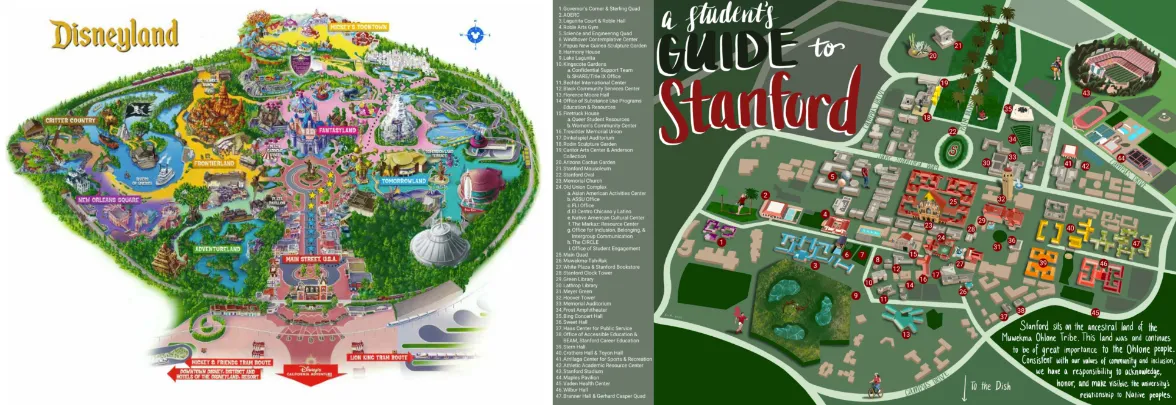Table of Contents
When describing Stanford to others, I always compare it to one place: Disneyland. Just like the theme park, Stanford’s picturesque campus grounds are perfectly maintained at all times, from the height of its bushes to the impeccable lawn that spells out the famous “S” logo on its Oval. A mix of Spanish-style architecture and modern science centers represents the best of both tradition and innovation to visitors. The Ivies’ dull campuses, despite their prestige, cannot compete with Stanford’s lively—dare I say, fun—aesthetic; our picturesque campus is partly what makes Stanford the most sought after “dream school” by neurotic high school seniors and helicopter parents alike.
Even my acceptance letter, which introduced me to a “joyful and welcoming campus community with a shared determination to make the world better,” oozed with the blind, romantic optimism reminiscent of a Disney film. The university’s signature image is that of an idyllic campus where “the wind of freedom blows,” with self-motivated and happy students needing little direction or restrictions to take full advantage of its phenomenal resources.
Stanford is indeed beautiful, but the veneer of blissful harmony is underlied by a system of excessive safety measures—bordering on theater—and synthetic attempts at community-building that hamper students’ ability to have rich social lives and the agency to fully explore and enjoy campus.
The most ridiculous of Stanford’s ubiquitous safety measures is the network of keycard scanners that control access to nearly every building. In an effort to avoid an embarrassing breach of campus security, these tiny machines ensure that nobody may open a door, lest they possess the proper identification. Therefore, students cannot access any buildings besides their own without the help of a friend or a passing stranger from within the residence halls.
This annoyance necessarily impedes simultaneous meetings within the residences, and makes dorm gatherings much harder to coordinate with friends from different areas. Meanwhile, any actual imposter looking to infiltrate Stanford’s hallowed halls could easily wait for an unsuspecting student to swing the entrance open and enter in, just as Will Curry did. As a result, normal students—not the boogeymen looking to creep into dorms—are the true victims here. When the University makes socializing more challenging, students do less of it.
The absurdity doesn’t stop there. Examine, for instance, the small enclosed outdoor area in Stern’s southeastern corner. When passing through to access the restrooms at Burbank, a keycard is needed to return to the central dining hall; despite the fact that the area is completely closed off to public streets. Good on Stanford for deterring roof-climbers from entering the dining halls, I suppose? The blaring alarms that sound after a dorm’s door is left open for the dangerously long span of ten seconds, followed by a robotic voice instructing you to “Please close the door to secure the building” while juggling your bags and phone, is icing on the cake.
The neutering of campus life and traditions—especially after the pandemic—is motivated by an ideology of risk-aversion, and tramples the freedom Stanford used to be known for. Stanford ceasing to sponsor Full Moon on the Quad, the erection of fences around Kappa Sigma and other fraternities, the repeated shutdowns of the inaugural all-campus Eurotrash Party, the abolition of the open door policy, and the cancellation of all-dorm ski trips all serve as mounting evidence of this trend.
These policies force the relegation of fun to behind closed doors and wristband-only parties. They prevent our campus from being a respite from other elite institutions by fostering vibrant social life alongside hardcore academics. Stanford’s skittishness around permitting any type of student-led amusement for fear of liability or bad publicity has a severe chilling effect on campus culture. Until these restrictions are reversed, each new class will continue to bemoan the erosion of long-standing campus traditions.
While each of these individual changes may seem inconsequential, they cumulatively erode the soul of campus life. My Stanford freshman experience is not ruined by one canceled trip to Lake Tahoe, or needing to spend ten extra minutes coordinating a meetup with friends to work around the keycard system. But in combination, these hindrances slowly chip away at the free-spirited, adventurous college experience that Stanford advertises. In its place, students receive a sanitized and stale environment which inhibits their ability to make the most of Stanford’s beauty.
The University’s safetyism undermines their artificial attempt to foster organic communities through the neighborhood system. Even the propaganda promoting the arrangement reeks of cartoonish soullessness, with one of the maps actually inspired by depictions of Disneyland and the other using the infamous Corporate Memphis style.
Grouping the vegan Columbae with Sigma Nu and having the row houses as arbitrary exclaves of regular housing does little to foster community. When Crothers residents (like myself) want to access the intra-neighborhood Branner Dining Hall, we are forced either to beg Branner residents to let us through the front entrance, or to take a five minute detour around the building’s backside. Meanwhile, Stern Dining—which is outside our neighborhood—is only a minute away from Crothers. Accordingly, the neighborhood housing restrictions have garnered widespread criticism for largely limiting students to their assigned zones for all four years, without fostering the coherent communities Stanford envisioned as a necessity for those housing restrictions.
Instead of striving to maintain its fantasyland facade, Stanford should instead cease its war on social life and allow its students to engage in the freedom that it loves to promote. Stanford must not shrivel into an “educational resort,” as one of my professors put it, run with the same soullessness and litigious spirit as a commercial Disney property.









